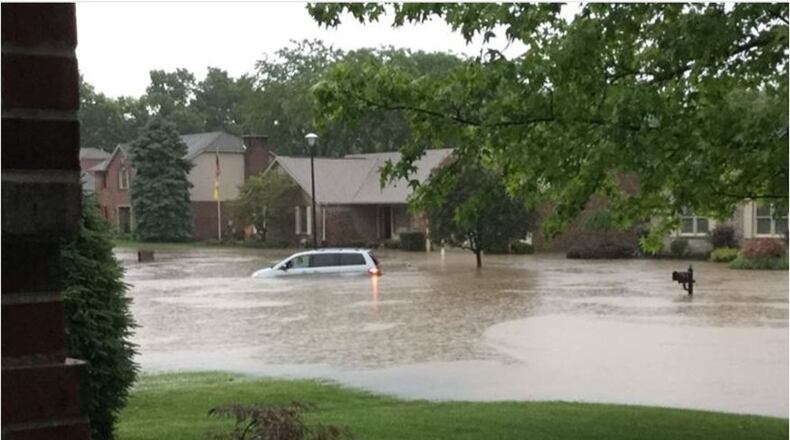That work should be able to begin within about six weeks, Director of Engineering Rich Engle said. Because the work depends on weather conditions, Engle said he did not know how long the work might take.
Like other parts of Hamilton’s West Side, the subdivision, located in the northern part of the city’s Washington neighborhood, just south of St. Clair Township, the Random Hill subdivision experienced flooding in 2017 after heavy storms.
“But after meeting with the residents multiple times, we discovered that they had been experiencing multiple flooding events since the 1990s,” Engle said.
Homeowners like Bill and Sherry Phillips of Tabor Lane hope the city can make a fix soon. Until then, they worry every time a big storm approaches that water will saturate the soil so much that it will overwhelm their sump pump again and flood their finished basement for a third time since they’ve lived there.
Sherry Phillips points to two houses across the street where former owners moved away because of the flooding threats. One flood was so significant on area streets that they were unable to drive to their house.
The flooding is caused by a combination of factors, including storm-water sewer pipes not built at sufficient sizes and the area’s topography, Engle said.
Two drainage ditches enter the area from the Beissinger Road area in the township. The city spoke with two property owners in the township, hoping to buy some of their property to install detention basins, “to try to reduce the amount of flow coming into the system, but we were unable to do so,” Engle told council.
“This is a top-priority project for us,” Engle said. “We’ve been working with the property owners to get something complete for them.”
The city soon will hire a contractor to install plastic liners inside the corrugated metal storm-sewer pipes that officials say can increase the pipes’ flow capacity. Although the liners will fit inside the existing pipes, which were undersized, they will make them more effective in draining rain water from the area.
That’s because corrugated pipes have many ruffles within them that slow the flow of water. The plastic linings inside them will be smooth, allowing water to flow through them 30 percent more effectively.
“The corrugations, if you think about it, do not allow the free flow of water,” Engle said. “So it acts with a higher friction factor. When you have a smooth wall pipe, the water flows easier and more smoothly through the pipe.”
With the plastic linings, “with one of our consultants who does computer modeling, we think it’s going to be very successful,” Engle said. “It’s going to reduce our street flooding substantially, down to just a few inches, rather than feet.”
Jim Logan, Hamilton’s executive director of infrastructure, said, “We thought we were basically going to have to dig everything up, expand the pipe size, go through a series of other things,” but the plastic lining of pipes can be a good alternative.
The city bid out the project in July, but was not satisfied with the bids it received.
“We’re just going to take another look at it and see what we can do to put another project out later this year for bid and see what happens,” Engle said.
In a related matter, Hamilton is completing its first Stormwater Master Plan, the first officials know of since one that was published in 1958, “so it was certainly time to have an update,” Engle said.
That plan will provide a proactive method approach to prioritizing storm-sewer projects and identify problem areas, he said.
Other goals for the new plan were to bring the city into compliance with regulations of the U.S.- and Ohio Environmental Protection Agencies, help extend the functional lives of storm-water infrastructure, identify resources that are needed and develop a prioritized 20-year capital plan for those sewers.
Among issues the city faces with its storm-sewer system is “we have over 15,000 feet of corrugated metal pipe that’s 36-inch and larger,” Engle said. Such large pipes are vulnerable to collapse, sometimes taking with them sidewalks.
About the Author
